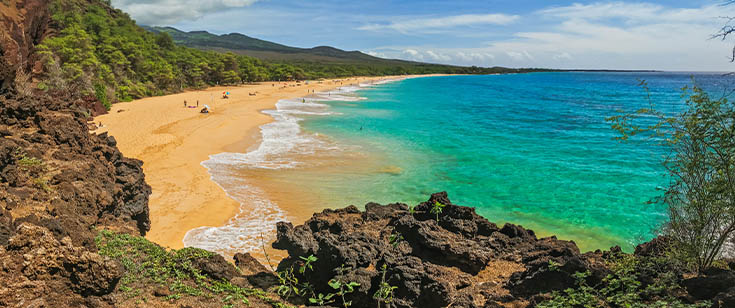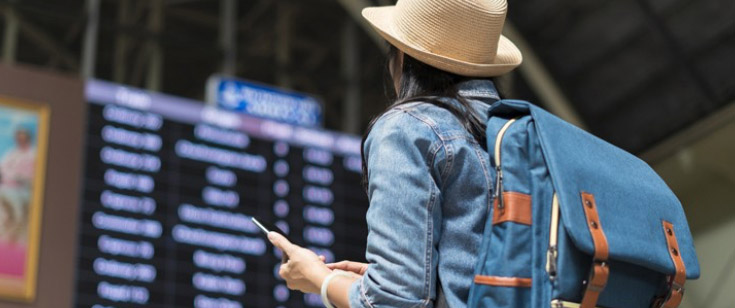As Highway 1 narrows north of the Central California town of Harmony (population: 18), it’s easy to imagine you’ve left all clutter and confusion behind. On one side of the road are golden meadows—cows grazing here and there—and rolling hills, at the top of which you can just make out a fairy-tale castle; on the other, the flat blue plate of the Pacific Ocean, scintillating in the sun. No trace of human habitation, nothing to remind you of the year or even decade; you’ve entered a world that seems to be governed by rock and crashing surf, high trees, and wide, blue horizons.
I’ll never forget the sense of liberation I felt, overwhelmingly, the first time I drove along the Big Sur coastline, just one month after acquiring my driver’s license, in 1973. Now, almost half a century later, nothing seems to have changed here except that this unspoiled stretch of road, winding around curves high above the sea, appears to be even more pristine and further out-of-time. I made the trip again last July, and then once more in October, as the season of staying close to home sprung loose in me a fresh awareness of all the wonders down the road that, too often, I sleepwalk past.
My journeys have always been lit up and guided by the great American explorer Henry David Thoreau. Yes, the man associated with Walden Pond journeyed up and down the East Coast, publishing books about Cape Cod and the Maine Woods; he even ventured up to Canada. But his central sentence in Walden, his most famous book, observed that he had “traveled a good deal in Concord,” near his Massachusetts home; and the book concluded, “It is not worth the while to go round the world to count the cats in Zanzibar.” Thoreau was an essential American traveler insofar as he measured distance inwardly; sometimes, he knew, we can see our lives turned around by a journey across town, even as a trip to Zanzibar leaves us unaffected. “It matters not where or how far you travel—the farther commonly the worse—but how much alive you are,” Thoreau pointed out.
During the season of enforced stillness that we hope will soon be far behind us, many of my friends have worried about the future of travel. I haven’t, because to travel is to find, very soon, that the destination is the least important part of any journey. The joy of transport has nothing to do with frequent-flier miles or passport stamps accumulated; it does not require locomotion for one to be moved. Travel is at heart about the meeting between one soul and something she doesn’t know, and that encounter will never grow old or disappear. Its form, its setting, may evolve constantly, as has happened already with the move from the horse-drawn carriage of Thoreau’s day to Henry Ford’s car to the Concorde, but its meaning persists even when we can’t easily board planes or trust ourselves to light-rail trains.
Soon after the coronavirus confined many of us to our neighborhoods last year, my wife, Hiroko, and I began to take walks together. We were in suburban Japan when the lockdown began, and each morning, we struck out in a different direction from the tiny, two-room apartment we’ve rented now for 28 years. One day, we came upon an entire bamboo forest lined with flowering cherry trees; uguisu, or Japanese bush warblers (which sound like nightingales), were teaching their young to sing. Other days, we came upon other treasures: lines of cherry trees shading a mile’s worth of rice paddies, an eighth-century pagoda illuminated in the warm spring night, my friend from the ping-pong club working his vegetable patch near the local, 16th-century shrine.
Then I flew back to my mother’s house in the hills of Santa Barbara—my mother, now 89, had just emerged from the hospital—and I started taking walks there, too. For the first time in the 53 years that my parents had lived on this solitary ridge above the Pacific, I went all the way to the end of the road, 25 minutes away.
One morning, I saw two peacocks strutting up from a neighbor’s driveway, flaring their blue tails. On four occasions, I saw a fox trotting past. I looked out on the blue ocean, sharp and clear in the silent, often motionless days and realized that this was as ravishing a vista as any I’d travel to Capri or Rio de Janeiro to see.
Soon, Hiroko flew over to join me, and I came to know the walk as well as the lines on my wife’s hand. Many times, early in the morning, there was mist and sunlight all at once—exactly the intermingling we so often drove up to Big Sur to see. One part of the hills was blanketed in fog; the other turned golden under deep-blue skies. We walked in and out of the shifting shadows as rabbits scuffled along the side of the road and hawks circled overhead. Every day the vista was different, and each morning felt like an adventure.
In the afternoons, Hiroko and I walked beside the ocean. We’d been spending time in the West for 31 years now, and we’d never thought to partake of this radiant blessing every day. At the local university there’s a grand lagoon, which was now completely deserted. We began to walk around it, and found a string of beaches. The blue of the lagoon water, white herons skimming over it, gave way to the richer blue of the sea glimpsed above the sand, with the cloudless sky above. Thoughtful souls have set up a whole network of trails along the cliffs and beside the water, and though my parents had worked at this campus for decades, I’d never known such a web of wonders existed.
Santa Barbara is not a huge town, but there was never a shortage of new glories to discover. One day, a seagull (“He looks like Marlon Brando,” said Hiroko) was walking beside the sea, which was all diamonding pinpricks of light. Ahead of us lay one long stretch of entirely unpeopled sand. If this was all I could see so long as virus rates were climbing, it still seemed more than enough for me.
Of course, we’ve been relishing the chance to visit other cultures again. Last year began for us with a journey through silent sublimity on a small cruise ship sailing around the Antarctic Peninsula. On our way home, we spent warm afternoons wandering the elegant streets of Recoleta, a neighborhood in Buenos Aires. We had all kinds of other trips planned for 2020—Bhutan, Aspen, Dublin (a place close to my childhood home that I’ve never seen)—all of which got postponed. But Bhutan will always be there, I hope, and for now I can taste Himalayan momos, or dumplings, 20 minutes from my Santa Barbara home. I can enjoy Irish music at a pub down the street, and I can hear the stories of Vietnam (and Iran and Guatemala and Ethiopia) without leaving California. Besides, whenever I touch down in one of those magical places, I’m reminded that the people there are often dreaming of Los Angeles.
I grew up going to school by plane from the age of 9, from my parents’ home in the hills of Santa Barbara to a series of dusty boarding schools in the country where I was born, England. I’ve been traveling almost incessantly for 46 years and feel hugely privileged to be part of the first generation able to inspect every corner of the global neighborhood. But learning to find wonder everywhere is a talent I can as easily develop—and deploy—close to home as in Tibet or Cuba.
Golden poppies will flood the slopes of Santa Barbara this coming spring. From my mother’s home I can spend hours just beginning to count the constellations. Those of us used to the dramatic changes of seasons in Japan (or in Thoreau’s New England) can see the same shifts play out more subtly amid the sharpened winter afternoons of Southern California, and look forward to the jacaranda flowering above the streets in May.
To travel means, ultimately, nothing more than coming back home a slightly different person from the one who left. That’s as possible in 2021 as it was two years ago. The world is inexhaustible, if only we can open our eyes and look with more care at what we so often take for granted.





